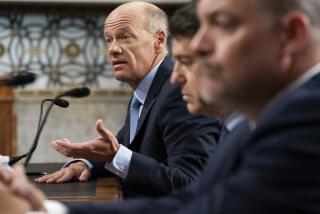Proposal to allow breakup of huge banks gains momentum
- Share via
Reporting from Washington — Momentum is growing in the U.S. and abroad to deal with the problem of gigantic financial institutions deemed too big to fail by breaking them up before they can threaten the economy.
Angered by bailouts that have kept corporate titans such as American International Group Inc. afloat, members of a key House committee last week voted to give the government vast new power to downsize private companies, something that happens now only in the most egregious antitrust cases.
Instead of helping cushion the fall of Wall Street powerhouses through government aid or variations on traditional bankruptcy, there is growing momentum in Congress to cut those firms down to size before they start teetering to limit the damage if they do collapse.
“The era of the big bank is over,” said Simon Johnson, an MIT professor and former chief economist at the International Monetary Fund.
The dramatic idea -- unthinkable before the financial crisis -- carries important ramifications for the future of the economy and the ability of U.S. financial institutions to compete with giants abroad.
Critics of the proposal point out that only a handful of the world’s largest financial firms are based in the U.S. They say mega-corporations need mega-banks to meet their needs.
Nevertheless, the call to limit the size of financial firms has come recently from former Federal Reserve chairmen Alan Greenspan and Paul Volcker, as well as some prominent economists. Europeans are considering a similar move, while the Fed’s British counterpart, the Bank of England, this month said it would require three of its bailed-out behemoths -- Royal Bank of Scotland, Lloyds Banking Group and Northern Rock -- to downsize.
Seizing on that momentum and the continued outrage over Wall Street’s bailouts and bonuses, a House committee last week voted to give U.S. regulators the power to preemptively break up large financial institutions that pose a “grave threat to the financial stability or economy of the United States.”
The breakup plan, part of an overhaul of financial regulations moving through Congress, goes much further than the “resolution authority” the Obama administration has requested.
Under the Obama proposal, the government would be able to take apart large firms only if they were are on the brink of bankruptcy and were so interconnected that their failure could cause economic chaos. That was the case with AIG last year before the Federal Reserve bailed it out.
But many lawmakers say the government needs the authority to break up companies engaged in risky behavior well before they get to the point of collapse.
“The American mind is asking . . . Are we going to allow institutions to put their lives, their children’s lives, the entire country at risk? Or can we take preventive action to prevent this risk?” said Rep. Paul E. Kanjorski (D-Pa.), who wrote the proposed breakup provision. He stressed that a breakup would be a last resort if other regulatory actions didn’t eliminate the potential threat to the financial system.
Senate Banking Committee Chairman Christopher J. Dodd (D-Conn.) has proposed similar power in his regulatory overhaul legislation.
The concept is simple, supporters said: The bigger you are, the harder you fall.
“When small guys screw up, we shut them down,” said Johnson, the former IMF economist, noting that more than 120 U.S. banks have failed this year. “We’re good at managing failure. What we can’t do is deal with the failure of big guys.”
Johnson said there had been no societal gain from the dramatic growth of Goldman Sachs Group Inc. and other financial firms over the last decade, and there’s no reason to believe that regulators will become more effective in reining in risky behavior.
When a huge financial institution teeters near bankruptcy, officials have to weigh the implications of allowing it to fail or bailing it out. Breaking up the firm before that point avoids the dilemma, he said.
“If you’re a big, trillion-dollar bank, the chances are the [U.S.] president will not want you to go through bankruptcy resolution,” Johnson said. “If it’s an $80-billion or $100-billion bank, the consequences will be more manageable.”
Four U.S. bank holding companies have more than $1 trillion in total assets: Bank of America Corp., JPMorgan Chase & Co., Citigroup Inc. and Wells Fargo & Co. Kanjorski’s proposal would require regulators to give special attention to the 50 largest financial institutions, those with more than $17 billion in assets.
Under that proposal, a forced divestiture of assets worth more than $10 billion could not take place without the Treasury secretary’s approval, and a divestiture of assets of more than $100 billion would require consultation with the president.
But it oversimplifies the problem to say just being big is bad or risky, said Rob Nichols, president of the Financial Services Forum, a trade group of the chief executives of the 18 largest U.S. financial institutions.
The group supports tighter regulation, such as requiring large firms to hold more capital as a cushion against losses. And it largely favors the administration’s plan to allow the government to seize and dismantle firms near failure to avoid the potential chaos of bankruptcy.
But unless the entire world cracked down on the size of their financial institutions, such a move by the U.S. would put the country at a disadvantage, Nichols said. Even if Britain and the European Union followed suit, huge Asian banks would step into the void, he said. “Boeing, Caterpillar, Coca-Cola, Microsoft . . . they can’t have their financial needs met at the Bank of Burbank. They need these large global financial institutions.” he said.
Jamie Dimon, CEO of JPMorgan Chase, said in an opinion piece in the Washington Post this month that the scale of huge firms such as JPMorgan helps provide better products and services. Large businesses in particular need banks operating globally that can handle complicated transactions and provide billions of dollars in financing.
“Capping the size of American banks won’t eliminate the needs of big businesses,” he said. “It will force them to turn to foreign banks that won’t face the same restrictions.”
Most Republicans oppose giving the government breakup power, saying it would violate the Constitution and could lead to the dismantling of nonfinancial institutions, just as General Motors and Chrysler were bailed out. Decisions also could be made for political reasons, warned Sen. Judd Gregg (R-N.H.), such as breaking up Coca-Cola Co. because soda can be unhealthful, or Wal-Mart Stores Inc. because its workers aren’t unionized.
Treasury Secretary Timothy F. Geithner also has problems with the idea. He noted last week that the now-defunct Lehman Bros. Holdings Inc. and Bear Stearns Cos. were relatively small, but their troubles still caused “a huge amount of damage.”
“It’s more complicated than just focusing on size, although size sometimes means more risky,” he told a congressional panel. “But the critical thing is, you need to make sure the system’s strong enough that you can let these firms fail and you don’t have the taxpayer exposed to their losses.”
If critics of gigantic financial firms are correct and there’s no real advantage to their extra size, then simply requiring them to hold more capital in reserve and toughening other regulatory standards would lead them to downsize on their own, said Douglas Elliott, an economics fellow at the Brookings Institution. But he believes those giant firms play an important role and should not be broken up preemptively.
“I think Congress’ view of it is very heavily covered by this populist anger, even hatred of the large banks,” he said. “What we don’t want to do is basically punish the economy as a way of having a satisfying chance to punch the bankers.”
But some lawmakers appear eager to deliver that punch as payback for the economic pain of the financial crisis.
Rep. Al Green (D-Texas) said: “Too big to fail is the right size to regulate, eliminate and break into smaller parts.”
jim.puzzanghera@
latimes.com
More to Read
Inside the business of entertainment
The Wide Shot brings you news, analysis and insights on everything from streaming wars to production — and what it all means for the future.
You may occasionally receive promotional content from the Los Angeles Times.











